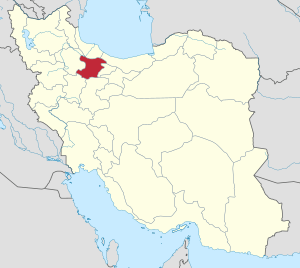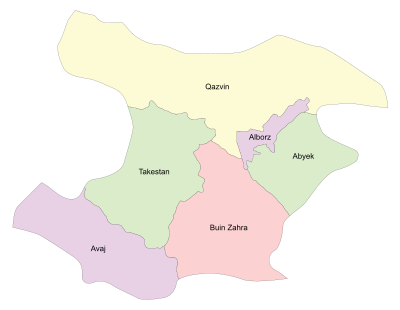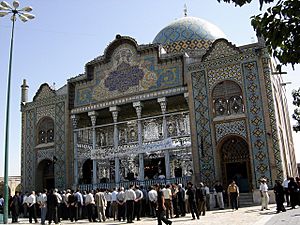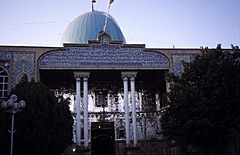Qazvin province facts for kids
Quick facts for kids
Qazvin Province
استان قزوین
|
|
|---|---|
 |
|
| Country | Iran |
| Region | Region 1 |
| Capital | Qazvin |
| Counties | 6 |
| Area | |
| • Total | 15,567 km2 (6,010 sq mi) |
| Population
(2016)
|
|
| • Total | 1,273,761 |
| • Density | 81.8244/km2 (211.924/sq mi) |
| Time zone | UTC+03:30 (IRST) |
| HDI (2017) | 0.796 high · 14th |
Qazvin Province (Persian: استان قزوین, Ostān-e Qazvīn) is one of Iran's 31 provinces. It is located in the northwest part of the country. The city of Qazvin is its capital. This province was created in 1993 from a part of Tehran province.
In 2016, the province had a population of about 1.27 million people. Most of these people (nearly 75%) live in cities. In 2014, Qazvin Province became part of Region 1. This was done to help with coordination and development across Iran's provinces.
In the northeast part of the province, especially in Alamut, many people speak dialects of the Mazandarani or Gilaki language. Some sources also say that many people in Alamut are 'Tats'.
Contents
History of Qazvin Province
Qazvin was once a capital city of the Persian Empire. It has more than 2,000 old buildings and historical sites. Today, it is still an important cultural center.
Ancient Settlements and Name Origin
Old discoveries in the Qazvin plain show that people lived in farming towns as far back as 7000 BC. The name "Qazvin" or "Kasbin" comes from an ancient tribe called Cas. This tribe lived south of the Caspian Sea thousands of years ago. The Caspian Sea itself also got its name from this tribe.
Qazvin has always been in a very important location. It connects Tehran, Isfahan, and the Persian Gulf to the Caspian seacoast and Asia Minor. This made it a key place for trade and travel throughout history.
Key Historical Events
Qazvin has seen many important events in Iranian history. Early in the Islamic era, it was a base for Arab forces. In the 13th century, it was destroyed by Genghis Khan. Later, in 1548, the Safavid rulers made Qazvin the capital of their empire. However, they moved the capital to Isfahan in 1598.
During the Qajar Dynasty and more recent times, Qazvin remained a very important government center. This was because it was close to Tehran. Abbas Mirza, who was a Crown Prince and Minister of Commerce, also served as the governor of Qazvin.
Qazvin is also near Alamut. This is where the famous Hasan-i Sabbah lived. He was the founder of a secret group called the Assassins.
In 1921, a major event happened in Qazvin. General Reza Khan launched a coup d'état from here. He was with his Russian-trained Cossack brigade. This event led to the start of the Pahlavi dynasty. In 1962, a big earthquake in Buin Zahra killed 12,225 people.
Geography of Qazvin Province
Qazvin Province covers an area of about 15,821 square kilometers. It is located between 48–45 and 50–50 east longitude and 35–37 and 36–45 north latitude.
Borders and Mountains
The province shares borders with several other provinces. To the north, it borders Mazandaran and Gilan. To the west, it borders Hamedan and Zanjan. To the south, it borders Markazi. And to the east, it borders Tehran Provinces.
The province has many famous mountains. These include Siälän, Shäh Alborz, Khashchäl, and Sephidkouh. Siälän is the highest peak at 4,175 meters (about 13,697 feet). Shäh Alborz is also very tall at 4,056 meters (about 13,307 feet). All these mountains are part of the central Alborz mountain range. The lowest point in the province is in Tärom e Soflä.
Climate
The climate in the northern parts of Qazvin Province is cold and snowy in winter. Summers there are mild. In the southern parts, the climate is generally mild. Winters are somewhat cold, and summers are warm.
Administrative Divisions
 Qazvin Province is divided into several counties. The population of these counties has changed over time.
Qazvin Province is divided into several counties. The population of these counties has changed over time.
| Administrative Divisions | 2006 | 2011 | 2016 |
|---|---|---|---|
| Abyek County | 89,334 | 93,844 | 94,536 |
| Alborz County | 182,046 | 203,276 | 242,865 |
| Avaj County1 | — | — | 43,798 |
| Buin Zahra County | 153,873 | 164,723 | 122,994 |
| Qazvin County | 530,961 | 566,773 | 596,932 |
| Takestan County | 171,520 | 172,949 | 172,636 |
| Total | 1,127,734 | 1,201,565 | 1,273,761 |
| 1Separated from Buin Zahra County | |||
Cities in Qazvin Province
Many people in Qazvin Province live in cities. The capital city, Qazvin, is the largest with over 400,000 residents. Other important cities include Abyek, Alvand, and Takestan.
Main Sights and Attractions
Qazvin is home to many interesting places to visit. There are archeological sites that are 9,000 years old. You can also find 23 castles nearby that belonged to the Ismaili Assassins. In the middle of the city, you can see the ruins of Meimoon Ghal'eh. This is one of several old Sassanid buildings in the area.
From the Safavid era, when Qazvin was the capital of Persia, there are still a few buildings left. The most famous one is probably the Ali Qapu mansion. Today, it is a museum in central Qazvin.
Historical Mosques
After Islam, Qazvin became a center for religious studies. This led to many mosques and religious schools being built. Some of the most beautiful ones include:
- Jame e Atigh Mosque: One of Iran's oldest mosques, built in 807 AD. It still stands today, even after the Mongol invasion.
- Heidarieh Mosque: This mosque was rebuilt after an earthquake in 1119 AD. Its history goes back to before Islam, when it was a fire temple.
- Masjed Al-nabi (Soltani Mosque): A very large and grand mosque built during the Safavid period.
- Sanjideh Mosque: Another mosque that was once a fire temple before Islam. Its current look is from the Seljukian era.
Churches and Russian Architecture
Qazvin has three buildings built by Russians in the late 1800s and early 1900s. These include the current Mayor's office (which used to be a Ballet Hall), a water reservoir, and the Cantor church. A Russian pilot is buried at the Cantor church.
For centuries, many Christians lived in Qazvin. The city is home to the Saint Hripsime church. It is also where four Jewish prophets are said to have predicted the coming of Jesus Christ. Their tomb is now a popular shrine called Peighambariyeh.
Castles and Forts
Many castles and forts in Qazvin are from the Isma'ili movement of the Middle Ages. Some of these include:
- Alamout Castle
- Lambesar Castle
- Meimoon Ghal'eh
Tombs, Shrines, and Mausoleums
A major attraction in Qazvin Province is the tombs of two Seljuk era princes. These tombs are in two separate towers called the Kharaghan twin towers. Built in 1067, they are special because they were among the first Islamic buildings to have a unique two-layered dome. Sadly, both towers were badly damaged by an earthquake in 2003.
Other popular shrines and tombs include:
- Imamzadeh Hossein
- Peighambarieh (where four Jewish prophets are buried)
- Hamdollah Mostowfi's Tomb: This is the tomb of a great historian and writer from the 13th and 14th centuries.
Traditional Reservoirs
In the past, Qazvin was known as the 'city of water reservoirs'. Out of about 100 old water reservoirs, only 10 remain today. They are protected by the Provincial Cultural Heritage Organization.
Bazaars and Caravanserais
Qazvin has some beautiful old Bazaars and caravanserais. These were places where traders and travelers could rest and do business.
- Sa'd-ol-Saltaneh Complex: A very famous and large complex.
- Qeisarieh
- Shah Abbasi Caravanserai of Avaj
Modern Towers and Shopping
Qazvin also has modern buildings. There are residential towers like Ponak and Sky. The Tejarat tower has 28 levels. For shopping, there are complexes like City Star and Ferdosi. You can also find a Proma Hypermarket.
Bridges
The province has several important bridges that help connect different areas. These include:
- Naderi
- Molasadra
- Persian Gulf (Khalij Fars)
Famous Parks
For outdoor activities, Qazvin has several parks:
- Mashahir in Shahrdai Street
- Barajin
- Melat
City Gates and Other Edifices
In the 9th century AD, Qazvin had seven gates to enter the city. By the Qajar period, there were nine gates around the city, connected by a wall. Today, only two of these gates remain because of city growth.
Other popular attractions include:
- Chehel Sotun Museum-Palace
- Hosseinieh Aminiha: A great example of traditional Persian homes in Qazvin.
- Shah Abbasi Bridge
Notable People from Qazvin
Many famous people have come from Qazvin Province:
- Ali Akbar Dehkhoda: A very important linguist and writer. He created Iran's first modern Persian dictionary.
- Obeid Zakani: A well-known poet and satirist.
- Hamdollah Mostowfi: A great historian and writer from the 13th and 14th centuries. His tomb is a historical monument in Qazvin.
- Táhirih: An influential poet and theologian.
Economy of Qazvin Province
Agriculture
About 13,000 square kilometers of land in Qazvin Province are used for farming. This is about 12% of all the farmable land in Iran. This land is watered by underground canals, wells, and a large irrigation canal from the Sangbän dam.
Farmers in Qazvin grow many different crops. These include grapes, hazelnuts, pistachios, almonds, walnuts, olives, and apples. They also grow wheat, barley, sugar beet, pomegranates, and figs. Raising animals, fish, and poultry is also an important part of the economy here.
Industries
In recent years, Qazvin has become an important industrial area in Iran. This is mainly because of its good location. Today, Qazvin is a center for making and trading textiles. This includes cotton, silk, and velvet. It also produces leather.
Qazvin is located on the railroad line and the highway that connect Tehran and Tabriz. This makes it easy to transport goods. The province also has one of Iran's largest power plants, called the Shahid Raja'i facility. This plant provides 7% of the country's electricity.
Colleges and Universities
Qazvin Province is also a center for education. It has several universities and colleges:
- Imam Khomeini International University
- Islamic Azad University of Qazvin
- Qazvin University of Medical Sciences
See also
 In Spanish: Provincia de Qazvín para niños
In Spanish: Provincia de Qazvín para niños
- Dineh Kuh






